
For years, the Ljubljana Airport has been Slovenia's window to the world – the country's only airport with regularly scheduled flights. In its half a century of existence, the airports has experienced a number of ups and downs – from state visits to horrific accident and even a major armed conflict.
Before the current airport was established near the village of Brnik some 25 kilometers from Ljubljana, Slovenia's only airport consisted of a modest, grassy field on the outskirts of Ljubljana. The new airport, which received its first plane – a prop-driven DC-6 --in December 1963, was touted as a major improvement, not just because it featured a paved runway and a modern terminal, but also because its location – at a higher altitude near the foot of the Karavanke Alps – supposedly made it less prone to fog than Slovenia's notoriously foggy capital. What planners did not know was that the area chosen for the new airport had a microclimate that also made it highly susceptible to fog, and delays and cancelations due to poor visibility were common during the airport's early years. (It wasn’t until new technology was introduced decades later that weather ceased to be a major hassle for passengers and airlines alike.)
It wasn't weather but pilot error that caused a horrific crash at the airport on September 1, 1966 – the first and only fatal accident in the airport’s history. A Bristol Britannia operated by Britannia Airways crashed while making a nighttime landing in Ljubljana. Apparently, the pilots did not set the altimeter improperly, and the airport's sloping runway caused an optical illusion that led them to believe they were higher than they actually were. The aircraft plowed into a nearby forest, and of the 117 people -- mostly British tourists -- abroad the plane, 98 lost their lives.
Despite the accident, the airport experienced rapid growth in the first decades of its existence. In addition to Belgrade-based Yugoslav Airlines, the airport was also served by the rapidly growing Adria Airways, a Slovenian charter based in Ljubljana. (Years later, Adria would become Slovenia’s national carrier.) The growth of revenue enabled the airport to enlarge its terminal and even to set up a subsidiary airport in the Croatian town of Pula.
By the late 1980s, the Yugoslav political crisis had worsened to such an extent that Slovenia embarked on its road towards leaving the federation. After it declared its independence in June 1991, Slovenia was attacked by the Yugoslav Army, resulting in the Ten-Day War. In the opening stages of the war, Yugoslav jets attacked the airport, killing two Austrian journalists and damaging several commercial aircraft.
The airport recovered from the war damage very quickly, but the consequences of the conflict and the dissolution of Yugoslavia lasted for years. Due to unstable conditions, Adria Airways had to relocate its base of operation to Klagenfurt, Austria, for several months, and even when it returned to Ljubljana, it took years for the volume of passengers to recover to its pre-independence numbers.
The new millennium brought a sharp increase in passenger numbers. A new type of airline played a major role in this development: the low-cost carrier. UK-based EasyJet, followed by Wizz Air of Hungary, began to serve Ljubljana and, for the first time, made flying truly affordable even to ordinary people.
The low-cost revolution brought a new development, however. Many Slovenians began to travel to other airports in the region – Trieste, Venice, Zagreb, Graz, and so on – in search of the lowest ticket prices. The Ljubljana Airport could no longer pretend it was a monopolist, but instead had to fight for passengers by mounting aggressive marketing campaigns to attract new airlines to the airport.
Slovenian independence also brought a new kind of guest to the airport: The international statesman. Since independence, the Ljubljana Airport has hosted everyone from Bill Clinton and Pope John Paul II to George W. Bush, and Vladimir Putin. The former provincial airport was now a national gateway used by prominent visitors from around the world.
While the economic crisis initially caused a drop in passenger numbers, they have recently stabilized. Whether the airport continued to serve Slovenia as a successful airport will depend on how well it navigates the choppy waters of cross-border competition. Its management is optimistic, and a new terminal to accommodate the planned growth will be constructed by the end of the decade.
Whatever happens, the airport is facing the future with a new name: In 2007, it was named after Jože Pučnik, an intellectual and a politician who was one of the earliest advocates of Slovenian independence. Because of the deep ideological divides within Slovenian society, the naming was not without its controversy, but many consider it fitting: The country's window to the world – its link with other nations -- is now named after a person who helped Slovenia join that community of nations as an independent state.

































































